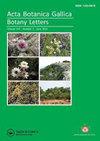Consequences of iceplant (Carpobrotus) invasion on the vegetation and seed bank structure on a Mediterranean island: response elements for their local eradication
引用次数: 19
Abstract
Abstract Biological invasions are one of the world’s leading causes of biodiversity loss. Islands are particularly good models for studying the impact of invasive species. Bagaud island (58 ha), which is part of Port-Cros National Park (southeastern France), is currently suffering an invasion of Carpobrotus. A restoration project has been established with the aim of eradicating these species to protect native ecosystems. The objective of the present study was to examine the plant composition of the local vegetation and seed bank (in litter and soil) focusing on (i) Carpobrotus patches and (ii) native plant communities, with the ultimate goal of determining whether Carpobrotus removal is followed by native plant community colonization. A further objective of this study was to help identify the most effective protocol for adequate ecological restoration. Native plant communities found around Carpobrotus patches can vary depending on whether the patch is located on the coast or inland; we can therefore expect a variety of plant communities to form following Carpobrotus removal. Even though Carpobrotus litter can frequently contain seeds of native species, such Atriplex prostrata, Frankenia sp. and Sonchus asper, it also contained many more Carpobrotus seeds (77.6%). Therefore, it is important to remove Carpobrotus litter to prevent large numbers of Carpobrotus seeds from recolonizing after eradication. We conclude that the most effective ecological restoration protocol consists of the following: (i) the removal of living Carpobrotus plants and (ii) the removal of Carpobrotus litter. This protocol can be made even more effective by following it up in the near and mid-term by periodic and thorough checks for Carpobrotus reinvasion.冰植物(Carpobrotus)入侵对地中海岛屿植被和种子库结构的影响:局部根除的响应因素
生物入侵是世界上生物多样性丧失的主要原因之一。岛屿是研究入侵物种影响的特别好的模型。巴戈岛(58公顷)是port - cross国家公园(法国东南部)的一部分,目前正遭受Carpobrotus的入侵。已经建立了一个恢复项目,目的是根除这些物种,以保护当地生态系统。本研究的目的是研究当地植被和种子库(凋落物和土壤)的植物组成,重点关注(i) Carpobrotus斑块和(ii)本地植物群落,最终目的是确定Carpobrotus清除后是否会有本地植物群落定植。这项研究的另一个目的是帮助确定最有效的方案,以充分恢复生态。在Carpobrotus斑块周围发现的本地植物群落可以根据斑块是位于沿海还是内陆而变化;因此,我们可以预期在Carpobrotus被移除后会形成各种各样的植物群落。尽管Carpobrotus凋落物经常含有本地物种的种子,如Atriplex prostrata, Frankenia sp.和Sonchus asper,但它也含有更多的Carpobrotus种子(77.6%)。因此,清除Carpobrotus凋落物以防止大量Carpobrotus种子在根除后重新定居是很重要的。我们得出结论,最有效的生态恢复方案包括:(i)去除活的Carpobrotus植物和(ii)去除Carpobrotus凋落物。通过在近期和中期对Carpobrotus再次入侵进行定期和彻底的检查,可以使该方案更加有效。
本文章由计算机程序翻译,如有差异,请以英文原文为准。
求助全文
约1分钟内获得全文
求助全文

 求助内容:
求助内容: 应助结果提醒方式:
应助结果提醒方式:


